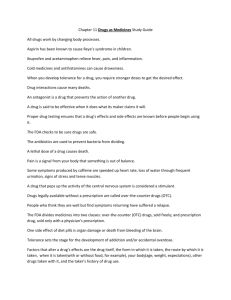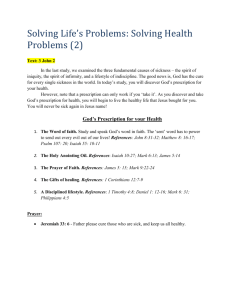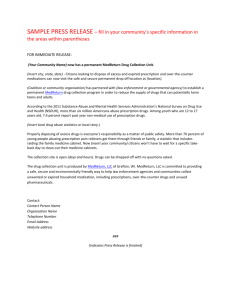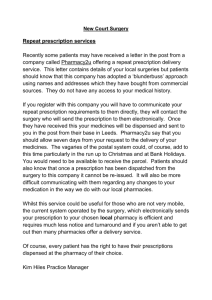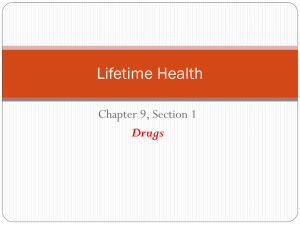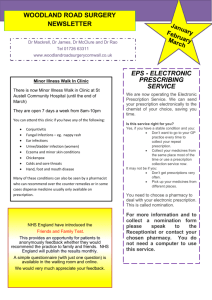the economics of prescription drugs
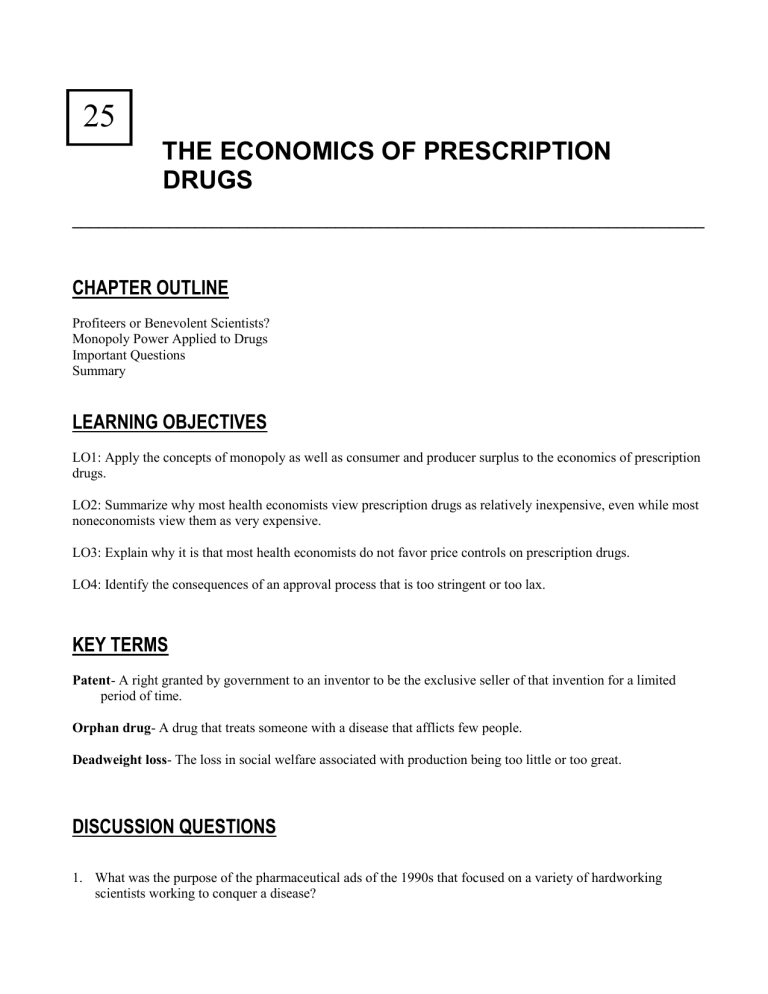
25
1
THE ECONOMICS OF PRESCRIPTION
DRUGS
________________________________________________________________________
CHAPTER OUTLINE
Profiteers or Benevolent Scientists?
Monopoly Power Applied to Drugs
Important Questions
Summary
LEARNING OBJECTIVES
LO1: Apply the concepts of monopoly as well as consumer and producer surplus to the economics of prescription drugs.
LO2: Summarize why most health economists view prescription drugs as relatively inexpensive, even while most noneconomists view them as very expensive.
LO3: Explain why it is that most health economists do not favor price controls on prescription drugs.
LO4: Identify the consequences of an approval process that is too stringent or too lax.
KEY TERMS
Patent - A right granted by government to an inventor to be the exclusive seller of that invention for a limited period of time.
Orphan drug - A drug that treats someone with a disease that afflicts few people.
Deadweight loss - The loss in social welfare associated with production being too little or too great.
DISCUSSION QUESTIONS
1.
What was the purpose of the pharmaceutical ads of the 1990s that focused on a variety of hardworking scientists working to conquer a disease?
2 Chapter 25
2.
What is a patent? What underlies the economic decision to grant patents in the prescription drug industry?
3.
Do you think that orphan drugs will be produced without patent protection? Cite some examples of diseases that are treated by orphan drugs.
4.
Use monopoly analysis to depict a drug company’s effect on consumer and producer surplus. Do the company’s actions create a dead-weight loss?
5.
What might elasticity of demand have to do with pricing of prescription drugs?
6.
Why are drugs cheaper outside of the United States?
7.
Do you consider pharmaceutical drug companies to be benevolent scientists or profiteers?
8.
Present some arguments for and against the FDA’s speeding up of the drug approval process.
9.
How can marginal analysis be used to evaluate the FDA’s drug approval process?
10.
Why do most health economists view drugs as relatively inexpensive?
11.
Prescription drugs are much cheaper in developing countries than in the United States. Why do you think that pharmacies can still profit by selling the products at such reduced prices?
12.
What is the purpose of drug advertisements in magazine, newspapers and television, if these drugs are only available by prescription?
13.
Recall the analysis of a monopoly. What is the problem of requiring pharmaceutical companies from charging no more than the perfectly competitive price for their drugs?
THE WEB-BASED QUESTION
The general public is concerned with rapidly rising prices of prescription drugs. Several articles contend that these high prices are more the result of advertising and promotion designed to keep profits high, rather than money spent for research and developing new drugs.
Answer the following based on the websites below the questions.
Why are pharmaceutical prices so high in the United States?
www.actupny.org/reports/drugcosts.html
www.washingtonpost.com/wp-dyn/content/discussion/2005/04/26/DI2005042601191.html
The Economics of Prescription Drugs 3
ANSWERS TO STUDY QUESTIONS
SUGGESTED ANSWERS TO THE DISCUSSION QUESTIONS
1.
The purpose of these ads was to persuade watchers to feel better about the industry in general, rather than to buy a particular drug.
2.
A patent is the right given by the government to an inventor to be the exclusive seller of a good for a limited period of time.
Some examples of diseases that are treated by orphan drugs are multiple sclerosis and Parkinson’s disease.
In the pharmaceutical industry, the economic implication is that, since the firms are given exclusive rights, they have monopoly power and can charge high prices and restrict quantity.
3.
Orphan drugs are drugs that treat those with a disease that afflicts few people. Since sales will be quite small, the firms do not expect sufficient profits to justify research. Patent protection, which gives monopoly power, is particularly important in the case of orphan drugs. This expected profit encourages firms to produce these drugs.
4.
The following diagram illustrates the effect of monopoly power on a drug company’s consumer and producer surplus.
$ A
MC = S
P
M
B
P
PC
C
F
E
MR
Demand
Q
M
Q
PC
Q/t
Comparing Monopoly and Perfect Competition in
Prescription Drugs
If the industry were governed by perfect competition, the price would be P
PC and the quantity Q
PC
.
The patent gives the firm monopoly power. Therefore, the price would be P
M and the quantity Q
M
.
The prescription drug firm charges a higher price and sells a smaller quantity.
Consumer surplus is reduced from ACP
PC
under perfect competition to ABP
M
under monopoly.
Producer surplus is similarly reduced from P
PC
CF to P
M
BEF.
The combined consumer and producer surplus is smaller under monopoly than under perfect competition.
4 Chapter 25
Furthermore, there is a dead-weight loss equal to the area BEC.
5. The preceding diagram shows that the more inelastic the demand curve (the steeper the curve), the higher would be the prices that the prescription drug company would set. The less elastic (the flatter the curve), the lower the prices.
6. Drug prices are cheaper outside the United States because in most countries overseas, drug prices are regulated.
7. One can argue that drug companies are both benevolent scientists and profiteers. On the one hand, they are really hardworking scientists endeavoring to conquer diseases and the fruits of their labor have improved the quality of life for millions. On the other hand, the companies have also made billions in profits.
8. The Food and Drug Administration (FDA) approves and regulates prescription drugs in the United States. In the early 1990s, the FDA was criticized for its lengthy approval process. An argument against this kind of approval process is that people die while waiting for drugs to be approved.
During the middle 1990s, the FDA experimented with a fast-track approval process. Some safety issues were missed and some drugs had to be pulled off the shelves. An argument against this fast-track process is that some people die if drugs are unsafe.
9. Marginal analysis of economics can be used to aid in the FDA’s decision-making process. The marginal benefit of increasing FDA stringency is the decrease in the health problems accruing to those who take approved drugs that later are found to be unsafe. The marginal cost of increasing FDA stringency is the foregone increase in the health of people who could have been treated but were not. The optimal degree of FDA stringency is where the marginal cost equals the marginal benefit.
10. Most health economists view drugs as relatively inexpensive because of the following reasons:
Drugs treat diseases that used to require surgery or went untreated.
Drugs have improved peoples’ lives and represent significant advances for people.
Some would classify them as luxuries, but some health economists consider them to be necessities.
11. Once a drug is produced, the marginal cost producing additional amounts is very small. It is therefore profitable for drug companies to sell drugs overseas to developing countries at a much lower cost than they are sold in the United States. The firms can recoup some of their production costs and consumers benefit both in the
United States and in the developing countries.
12. The purpose of prescription drugs advertisements is to shift their demand curves to the right by informing potential consumers of the drug about the ailments that it treats. Sometimes, all the consumer has to do is inform their doctor that they have the symptoms (for example, restless legs) described in the advertisements to get the drug prescribed.
13. The problem is that the perfectly competitive price is below the firm’s average total cost, therefore, the firm would not product the product (drug).
The Economics of Prescription Drugs 5
SUGGESTED ANSWER TO THE WEB-BASED QUESTION
One recent article describes how spending on prescription drugs is now the fastest growing portion of health care spending in the United States. It also suggests that the pharmaceutical companies in their quest for huge profits have discovered that “direct-to-consumer prescription drug advertising” is working so well that the average number of prescriptions per person in the United States has increased from 7.3 in 1992 to 10.4 in
2000. In addition, the more expensive medications happen to be those that are the most advertised. The researchers also found that doctors tend to prescribe what their patients request.
Other authors contend that high drug prices are the result of the pharmaceutical companies’ quest to keep profits high, while at the same time covering advertising and huge executive salaries.


